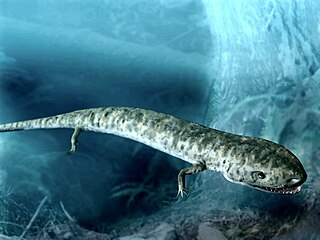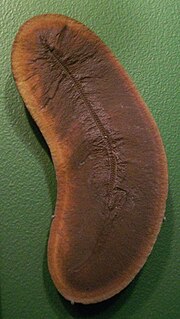 W
WBrachydectes is an extinct genus of lysorophian amphibian that lived from the Carboniferous. It had a very small head and an elongated body up to 43 cm long.
 W
WGymnarthridae is an extinct family of tuditanomorph microsaurs. Gymnarthrids are known from Europe and North America and existed from the Late Carboniferous through the Early Permian. Remains have been found from the Czech Republic, Nova Scotia, Illinois, Texas, and Oklahoma.
 W
WHapsidopareiontidae is an extinct family of tuditanomorph microsaurs. Hapsidopareiontids are known from the Early Permian of the United States and possibly Germany and the Czech Republic.
 W
WLysorophus is a genus of Lysorophia, extinct Permian Lepospondyl tetrapods. Most of the specimens are found from North America and attributed to the first formally described species Lysorophus tricarinatus due to the lack of diagnostic characters, but several other species have been described. Lysorophus were small salamander-like amphibians. They lived in fresh water, aestivating in burrows during dry periods.
 W
WMicrosauria is an extinct, possibly polyphyletic order of tetrapods from the late Carboniferous and early Permian periods. It is the most diverse and species-rich group of lepospondyls. Recently, Microsauria has been considered paraphyletic, as several other non-microsaur lepospondyl groups such as Lysorophia seem to be nested in it. Microsauria is now commonly used as a collective term for the grade of lepospondyls that were originally classified as members of Microsauria.
 W
WOstodolepidae, also spelled Ostodolepididae, is an extinct family of Early Permian microsaurs. They are unique among microsaurs in that they were large, reaching lengths of up to 2 feet (61 cm), terrestrial, and presumably fossorial. Ostodolepid remains have been found from Early Permian beds in Texas, Oklahoma, and Germany.
 W
WPelodosotis is an extinct lepospondyl amphibian.
 W
WPhlegethontiidae is a family of extinct aistopod amphibians including the genera Phlegethontia and Sillerpeton.
 W
WPhlegethontioidea is a clade of aistopod amphibians including the families Phlegethontiidae and Pseudophlegethontiidae. It is a stem-based taxon defined in phylogenetic terms as all aistopods sharing a more recent common ancestor with Phlegethontia than Oestocephalus.